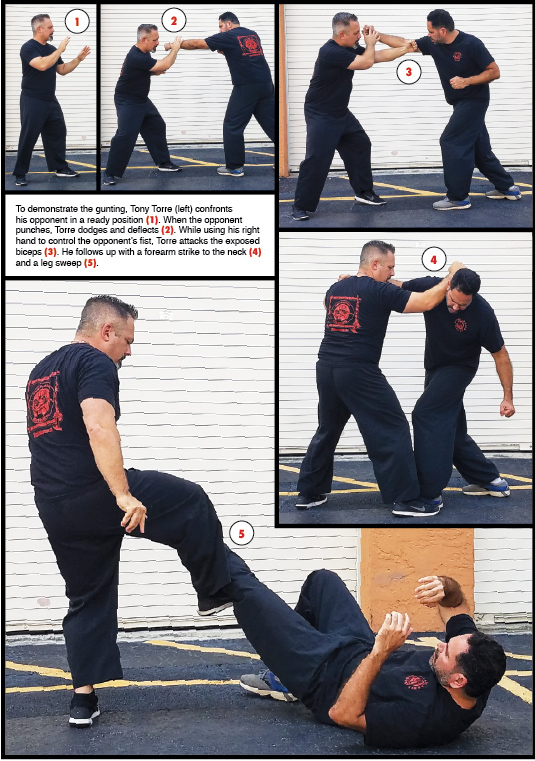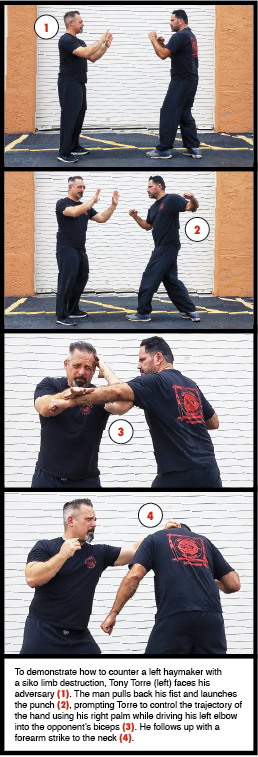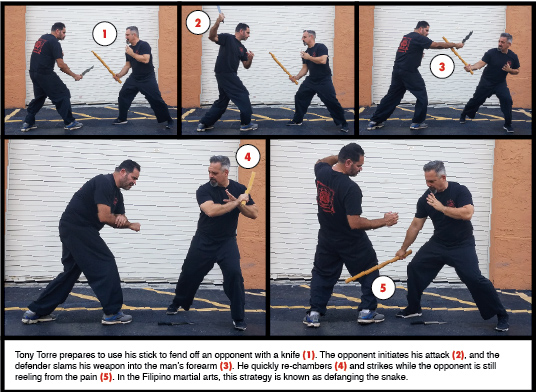LIMB DESTRUCTIONS FROM THE FILIPINO MARTIAL ARTS
BY TONY TORRE | PHOTOS COURTESY OF TONY TORRE
Anyone who’s been around the martial arts long enough no doubt has heard a certain boxing maxim: Make him miss and make him pay. That’s all well and good, but what if there was a way to just make him pay and immediately reverse the momentum of the fight? It just so happens that there is.
The Filipino martial arts teach a strategy called “defanging the snake.” It has you literally attacking your opponent’s incoming limb before it can do any damage. While this fighting tactic clearly stems from the influence that armed combat in the Philippines has had on the greater martial arts community, one should not think for a moment that it doesn’t apply equally well to empty-hand skills.
In the empty-hand training sessions I organize for my arnis students, we refer to this category of techniques as limb destructions. Their role in armed combat is the same as it is in unarmed combat: to exploit the fact that the opponent is reaching toward the defender. Because all martial artists intuitively understand where their body is in space relative to their opponent, this path to victory is clear: Deny him his target and replace it with your weapon so that it’s the opponent, and not you, who is injured.
But just because the path is clear doesn’t mean it’s easy to pull off. In reality, a limb destruction is a skill that needs to be practiced seriously by any martial artist who wishes to make it a reliable tool in his or her arsenal. Once mastered, though, it will become a prized possession that can be used to bypass the purely defensive initial phase of a violent encounter.
Stages
If you dissect the art of fighting into its various components, you’ll notice that altercations have three stages. Yes, the stages can be repeated several times within the same battle until a conclusion is reached, but basically they are the only distinct parts of combat. They are the entry, the follow-up and the finish. If you knock out your foe with a single punch, all three stages are embodied within that punch. If you’re in a fight involving multiple technique exchanges, there will be multiple entries and follow-ups until the finish occurs.
The advantage that the defanging-the-snake concept bestows is it allows you to remove an important time suck, the delay that normally occurs between a purely defensive action such as a block or cover and the moment you inflict injury in an effort to end the threat. In essence, you convert his opening move into the first part of your counter. Once you’re able to seize the offensive, you quickly can turn the momentum in your favor.
Clearly, defanging the snake operates on a physical level, but it also can have a huge psychological effect. When he attacks, your opponent expects to hit or miss you, but he certainly doesn’t think he’ll feel sudden pain. That, in a nutshell, is the brilliance of limb destructions. Many times, one can be enough to crush an adversary’s fighting spirit.
Caveat
I won’t underestimate your intelligence and tell you that knowing how to defang the snake will lead to easy victory. Anytime you find yourself in a fight, it has the potential to become a lethal encounter. That’s why good instructors will caution you never to underestimate your opponent or his resolve. And never overestimate a tactic or technique in your toolbox.
Treat defanging the snake as any other weapon in your arsenal. Learn where it will be most appropriate because — just like with disarms — depending on a limb destruction rather than the totality of your martial arts skill set is foolish. Doing so will leave you vulnerable to an opponent who knows better than to play the game you want him to play.
A superior self-defense plan entails developing all your offensive and defensive skills to the highest possible level. Once your go-to techniques and tactics are reliable and your overall skill base is solid, start experimenting with the limb destructions shown here. Then spend time fine-tuning those that fit your way of fighting.

Requisites
To be able to implement a limb destruction, you must possess a good sense of timing, as well as defensive skills that are second nature. Practitioners of different martial arts will depend on different methods to get into the most appropriate ranges for launching their counteroffensive. Knowing this is critical when you first attempt to use limb destructions because you’ll need to focus on those that are closely related to your natural defensive tendencies.
Another factor to keep in mind is that limb destructions work because they afford you the same level of defense as your passive defensive skills — while simultaneously adding that aforementioned element of pain. In other words, even if you don’t injure your opponent’s limb, you’ve still fended off his attack. In a properly executed limb destruction, you never have to gamble that a failed defang means you’re getting bit by the snake.
Training
Over the years, I’ve found that the best way to develop this tool set is to focus on one destruction at a time during sparring. Defend normally most of the time, but try a limb destruction on one of your opponent’s strikes — perhaps a jab or lead-hand punch.
Once you’ve become successful with that, refine it during “handicapped sparring” against the same attack. Handicapped sparring refers to sessions in which you purposefully limit the techniques you use. When you’ve mastered that, test it in free sparring against various opponents. When you deem it reliable, move on to the next destruction. Approaching the task in this manner means you’ll be able to quickly dismiss the moves that don’t suit your style and focus on those that are higher percentage for you.
In my arnis classes, I like to introduce a limb destruction to my intermediate students and have them practice it in partner drills. Then I have them try it in sparring. Once we’ve done this with a particular set of destructions and identified which ones are most suitable for each person, we work on tactics that reinforce those destructions. At this point, coaching is critical.
It’s essential to remember that not all limb destructions are suitable for all martial artists. If you’re an instructor, it’s your job to keep in mind that the focus of any fight — and the focus of all training — is to enable the student to get to the finish line as quickly and safely as possible.

Gunting
While it would be impossible to describe every limb destruction in the Filipino martial arts in one article, this tutorial would be sorely lacking if it didn’t include at least a few. The two we’ll explore are the infamous gunting (Tagalog for scissors) and the siko (Tagalog for elbow) limb destructions.
The gunting techniques are often preferred by counterfighters who use quick footwork and mobility as their primary defensive strategy. A gunting depends on your ability to parry. When facing an opponent who likes to jab and run away, a gunting can work especially well.
Practice the technique as shown in the accompanying photos. Make sure your head is off the line of attack. Remember that a fore-knuckle punch to the biceps will make that arm heavy to hold up — and can cause your adversary to drop it altogether. That makes this move a great strategy for those who like to counter off their opponent’s jab.
Experiment in class. After the gunting, try a cross, an overhand or a rear-hand punch of your preference. Then immediately follow up with more punches.
If your defensive skills include blocking and exchanging in middle range, try pairing your gunting with an inside block to stop your opponent’s cross or straight right. The block can be followed with a lead hook and a cross.
Often, it’s preferable to punch your opponent in the face using a split entry because it can lead to a quicker finish. However, if you’ve already tried it and he became a little squeamish and no longer closes as aggressively, this destruction just might be your ticket to victory.
In training, I’ve seen opponents who let their arms become entangled when this limb destruction is tried, especially if both parties are aggressive. In such cases, a head butt can work wonders. It also can serve as an entry into a clinch — but that’s best discussed in a separate article.
Siko
The category of limb destructions known as siko is favored by martial artists who prefer to cover while moving in. These fighters also tend to operate at close range, so if you’re one who favors infighting, I recommend you look into the siko techniques.
These destructions work by turning your passive cover into a pointy exoskeleton — hopefully, one that your opponent will impale a body part on. For a good visual, picture him punching a rhino’s horn. In one example, the opponent opens with straight punches. You execute a destruction, then move inside to get out of his preferred range. At that point, if you’re a fan of clinching, you’ll be at home. Likewise, those who like to throw hooks and elbows as follow-ups are likely to be successful.
I especially like siko techniques for countering wide hook punches. The terminal effect is very similar to a gunting aimed at the biceps, but it requires significantly less effort on your part. Depending on your opponent’s reach and timing, you might be able to also spike him in the sternum, thus impeding his forward momentum.
As with the split entry mentioned earlier, timing and range will determine what’s most appropriate. Experience will help you realize that height and reach are also important factors. Never forget that the goal is to prevail. The exact destruction you use to do that is not important. Go with what’s most appropriate for the circumstances.

Prognosis
Regardless of which limb destructions you wind up favoring, understand that every one that you add to your arsenal will need to pair well with your other defensive skills. The methods described here work off different timing: The gunting are more proactive, while the siko are more reactive. Sometimes the right choice boils down to that, and sometimes it boils down to nothing more than personal preference.
No matter which set of destructions you choose to adopt, don’t dismiss the possibility of mixing them up in a fight. Moving in and out of the various ranges can provide opportunities — in other words, a technique you didn’t consider initially might work later on.
In closing, I would like to remind you these techniques are just tools in your arsenal. They’re intended to be used in a fight — not a punching fight, a clinching fight or a limb-destruction fight. Just a fight. The tool you employ in any given altercation ultimately is less important than your survival. Work on developing skills that are congruent with that goal.
Tony Torre teaches arnis in Miami.
![]()
